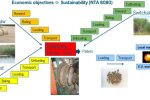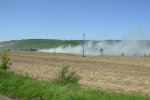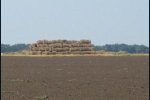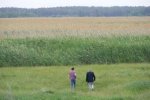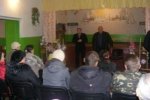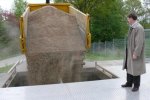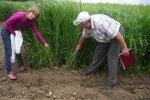
Project
Pellets for Power
Sustainable biomass import from Ukraine
This project has been funded by NL Agency under the Sustainable Biomass Import Programme.
Context and reasons to start the project
This project responds to the mismatch between on the one hand a growing demand for biomass on the Dutch and EU energy markets with a limited biomass potential and on the other hand large amounts of biomass and biomass potential currently underutilised in Ukraine. Ukraine itself is seen as a very promising location for sustainable biomass production but is also plagued by economic depression, land degradation, depopulation and high cost for natural gas.
The Ukrainian company Phytofuel and the Belgian company Tuzetka recognized the opportunity. Together with Wageningen UR in The Netherlands they started the first experiments with switchgrass and also initiated pelletisation of straw and assessed the opportunity to use available reed stands in the Poltava region. In 2010 the sustainable Biomass Import Programme (DBI) offered the opportunity to speed up the business development and also focus on certification. The programme helped to involve state of the art expertise for developing the total system and assure that the concept would comply with the (future) sustainability demands. This would mean that the pellets would be certifiable (in this case NTA 8080) and would also not compete with food production and would thus be iLUC free.
Objectives of the project
The project aimed to:
- Develop a sustainable business model for pelletizing biomass residues and biomass crops in Ukraine for domestic and NL energy markets.
- Test sustainability of underutilized biomass use and energy crop production on marginal land while avoiding indirect Land Use Changes (iLUC).
In Figure 1 the concept of using 3 types of herbaceous biomass (straw, reed and switchgrass) to secure a continuous biomass supply for production of pellets for the local and export markets is illustrated.
Straw is abundantly available in Ukraine and has very limited other uses. It was thought that using this biomass for pellet production and export to Europe through the Netherlands would be an attractive option. Reed is also potentially available in large quantities in Ukraine and has very little uses and is often burnt in winter to allow access to water.
Switchgrass is a perennial grass developed in the USA and later in western Europe as a biomass crop which can be grown at low cost on relatively low quality soils.
By using these 3 different types of biomass for supplying pelleting facilities a more or less continuous biomass supply could be achieved; straw in summer and fall, reed in winter and switchgrass in winter and spring. The business would be started using straw and then switch to also using reed and later switchgrass as these options would become available.
The production chains would be set-up to comply with biomass certification demands as set by the NTA 8080 certification standard to be sure the biomass pellets would have access to the European and Dutch biomass markets.
As all 3 three types of biomass could be produced without competing with other (food) applications it would be possible to claim that the biomass would be iLUC (indirect Land Use Change) free. This is one of the large sustainability problems that many other biomass options face at the moment.
Main findings of the project
What was the case for or against straw pellet production in Ukraine?
The straw potential in Ukraine is very large. Some 10 million tons of DM is assumed to be available every year, mainly because few alternative uses such as animal bedding or other applications like mushroom production or card board production are available. Because it is a by-product a positive GHG balance is very likely. In current practice straw is often burnt in the field (as illustrated by Figure 2).
During the project the commercial partners worked on setting up a production chain for straw pellet production but in the end concluded that straw was, for their business, a less attractive option. Security of supply was a concern due to uncertainty over the honoring of contracts by straw suppliers. Cost of logistics was a problem due to the low amount of straw available per hectare which increased the cost of straw collection. During the project it also became clear that the quality of straw pellets would pose a problem for most boiler systems due to the high potassium (K) and chloride (Cl) content of straw. High K and Cl content will lead to fouling of the boilers and ash melting (see Figure 3). Most existing boilers cannot handle this type of material and the market for straw pellets will therefore be very limited and the price paid will also likely be too low to make an attractive business proposition possible.
On top of this a model study, in the project , showed that under current conditions the harvest of straw without decreasing the soil carbon is not possible in most cases for the project area (Poltava, Ukraine). This is due to the high soil organic carbon contents of the soils in Poltava, making it very difficult to maintain soil organic carbon levels when used for arable agriculture. Especially given the low cereal yields and consequently low input of carbon through the roots and the stubbles and the low input of other organic matter like manure. The potential for straw harvesting can be increased by increasing cereal yields and more manure application. Maintenance of soil organic carbon is most critical NTA 8080 criterion for the straw chain.
Why is reed an attractive biomass source and what was achieved in developing this chain?
Wetlands consisting mainly of reed, cover approximately 1,2 million ha in Ukraine. Reed can yield up to 15 tons of dry matter per hectare per year. Most reed in Ukraine has no alternative uses and much reed is actually burned in winter or spring to make hunting and fishing possible. Controlled harvesting can actually benefit key marshland birds.
Using reed for energy pellet production is therefore a potentially attractive option. At the same time the wetlands are a vulnerable ecosystem and care has to be taken to maintain them. Harvesting the reed areas is complicated and potentially costly.
An important challenge (and success) in the setting up of a successful reed pellet production chain by the project was the acquisition of concessions for harvesting reed in the Poltava project region by partner Phytofuels. This involved defining the legal status of reed areas before concessions from the local communities could be obtained . This effort should also benefit other initiatives focusing on certified reed harvesting for energy purposes in Ukraine.
The quality of reed is potentially much better than for (summer harvested) straw because K and Cl have been washed out of the reed during winter. Thus ash melting and fouling problems can be reduced or avoided by harvesting reed in winter or early spring. The total ash content can still be a problem and require adaptations to boilers and good production chain management. The viability of reed pellets for thermal conversion was shown by a reasonably successful test in the municipal biomass heating installation in Marum (the Netherlands) in the spring of 2013.
The project provided best practices for reed harvesting which included recommendations to harvest in winter and to reduce the harvesting frequency to once every two years, and leave at least 25% of older reed and natural areas untouched. It also showed that the use of wetlands can contribute to social wellbeing, and increase income for local communities. It was concluded that the requirements for NTA8080 can be met, though some amendment may be needed to the strict rules regarding wetlands in the NTA8080. Further activities will need to concentrate on development of the local market for reed biomass for heat production and the efficient but still sustainable harvesting of reed. The market acceptance will also depend on the quality of the delivered biomass meaning mainly that it is low in ash and low in K and chloride Cl.
Why should switchgrass be an attractive biomass crop for Ukraine and what has been achieved in the project?
Switchgrass is a warm season (C4) perennial biomass grass developed in North America and introduced to Western Europe in the 1990’s. Switchgrass was introduced to Ukraine by the project partners in 2008. Switchgrass is seeded and has a productive life of more than 15 years when used for biomass production. To obtain good quality for thermal conversion and reduce the need for nutrient inputs harvesting is recommended after a killing frost preferably in winter or early spring.
The crop should be attractive in Ukraine because switchgrass can be established at low cost by seed (contrary to Miscanthus of short rotation coppice willow) and requires few inputs. Therefore it may be possible to establish large areas at relatively low cost. This is especially attractive when land is inexpensive, capital is expensive and the price of biomass is still low as is the case in Ukraine. Also switchgrass is thought to be able to give reasonable yields under lower quality soil conditions. This last issue is relevant if competition for land for food production is to be avoided.
Within the project, switchgrass experiments were carried out by Poltava State Academy, the Sugar Beet Institute and Phytofuels at 4 sites in Ukraine . Tests showed what varieties are adapted to Ukraine, when and how switchgrass can be established, what row spacing is best suited and what management should be applied. The tests also gave an indication of the potential yields for switchgrass. The project data and experience gained was used to write a first manual for growing switchgrass in Ukraine. Last but not least, expertise was generated in Ukraine to be able to establish large scale switchgrass fields with confidence, as evidenced by the successful establishment of large (> 5 ha) fields in the Lviv region of Ukraine.
Switchgrass is now an option for large scale biomass production, though testing should be continued to optimise production practice, reduce cost and also focus on delivery biomass of the right quality for thermal conversion.
What markets exist for reed and switchgrass pellets in Ukraine and the EU now and in the future?
At this moment there is only a limited market for “herbaceous pellets”. By herbaceous pellets all non-wood pellets made from grass type biomass like straw, reed and switchgrass is meant. This is mainly due to the higher ash content and risk of ash melting and fouling problems during combustion due to higher K and Cl contents compared to wood. Herbaceous biomass will always have higher ash contents and also more K and Cl. At the same time, as was shown for reed within this project, acceptable biomass quality for thermal conversion can be achieved, though not within the quality standards made for (wood) pellets. The possibilities to get access to market in Ukraine and in Western Europe and the Netherlands were analyzed by project partner Tuzetka and options for market development were proposed. It was concluded that project partners should first focus on supplying local (Ukrainian) markets with biomass for heating (this is now taking off) while at the same time focusing on lowering cost in increasing quality. Economy of scale could be increased by collaboration between producers and thus be able to also provide security of supply to customers. Export of pellets for bedding to European markets, may be an option if the right quality is delivered and sanitary concerns can be addressed. Ultimately, herbaceous pellet standards and conversion facilities adapted to herbaceous biomass will be needed to really tap into the potential herbaceous biomass (pellets) provides.
What has been the contribution to the iLUC debate by the project?
The project proved the viability of harvesting an unused biomass resource, reed, which should not lead to competition with food production and no indirect Land Use Change and the associated GHG emissions.
The project also showed that it may be possible to grow biomass crops (switchgrass) on marginal/underutilised land, which should avoid iLUC . It was also shown that this will lead to higher cost per unit of biomass produced and to higher GHG emissions per ton of biomass produced (within the production chain) when compared to growing the crop on good quality land. Producing iLUC free biomass may therefore only be attractive if iLUC free biomass is somehow rewarded and GHG balance demands are not outside of reach. It may also be necessary to define the “marginal” areas where growing perennial biomass crops is possible or preferred.
Funding
Pellets for Power project has been funded by NL Agency under the Sustainable Biomass Import Programme
Reports to download
- Elbersen Pellets for Power Kiev 25 September 2013.pdf (797,75 kb)
- Elbersen, Wolter (ed), Ronald Poppens, Jan Peter Lesschen, Theo van der Sluis, Maryna Galytska, Maksym Kulyk, Patrick de Jamblinne, Petro Kraisvitnii, Oleksii Rii, Tjipke Hoekstra. Pellets for Power: Sustainable biomass import from Ukraine. Public Final Report. For the Netherlands Programmes Sustainable Biomass of NL Agency. (749,42 kb)
- Poppens, R., and T. Hoekstra. 2013. Ukrainian biomass sustainability. Assessing the feasibility of sustainability standard implementation and producer compliance in Ukraine. Pellets for Power project. Wageningen UR Food & Biobased Research. (667,94 kb)
- Poppens R., J.P. Lesschen, M. Galytska, P. de Jamblinne, P. Kraisvitnii, H.W. Elbersen. 2013. Herbaceous biomass supply chains. Assessing the greenhouse gas balance, economics and ILUC effects of Ukrainian biomass for domestic and Dutch energy markets. Pellets for Power project. Wageningen UR Food & Biobased Research. (1,5 mb)
- Poppens, R., P. Kraisvitnii, O. Rii. 2013. Taking the Law to the People – Mobilizing community ownership for legal reed harvesting in Ukraine Experiences with Ukrainian legislation and stakeholder consultations for commercial reed harvesting in rural communities. Pellets for Power project. Wageningen UR Food & Biobased Research. (1.022,22 kb)
- Sluis van der, T., R. Poppens, P. Kraisvitnii, O. J.P. Lesschen, M. Galytska and H.W. Elbersen. 2013. Reed Harvesting from wetlands for bioenergy. Technical aspects, sustainability and economic viability of reed harvesting in Ukraine. Pellets for Power project. Alterra report 2460. (8,63 mb)
- Elbersen H.W. and M. Kulyk. 2013. Switchgrass Ukraine. Overview of switchgrass research and guidelines. Pellets for Power project. Wageningen UR Food & Biobased Research. (1.018,54 kb)
- Jamblinne de P. 2013. Market potential of Ukrainian herbaceous biomass. Analyzing market obstacles and promoting business strategies. Pellets for Power project. Tuzetka S.A. (1,87 mb)
- Lesschen, J.P., W. Elbersen, R. Poppens, M. Galytskaya, M. Kulyk and L. Lerminiaux. The financial and GHG cost of avoiding ILUC in biomass sourcing - A comparison between switchgrass produced with and without ILUC in Ukraine. In. Eur. Biomass Conf. June 18-23 2012. Milan. (57,06 kb)
- Elbersen H.W. and R. Poppens The concept of “Fuel AND Food” explained (2013). (219,16 kb)
